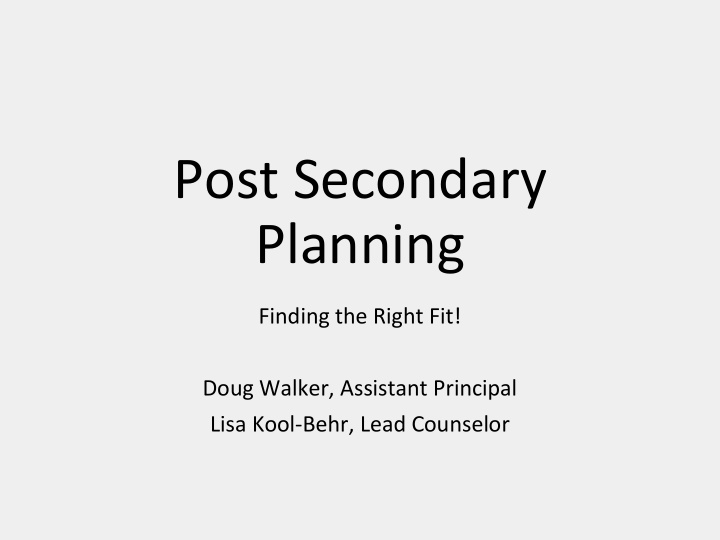



Post Secondary Planning Finding the Right Fit! Doug Walker, Assistant Principal Lisa Kool-Behr, Lead Counselor
Agenda • Summary of Historical College Placement Trends • Strategies for Determining Fit • Preparing for Junior Conferences • Naviance
College Placement
College Placement By Type of Institution Competitive Total Percent Category Most 123 41% Highly 47 16% 85% Very 84 28% Competitive 37 12% Less/Non 8 3% Special/Other 2 <1%
GPA Distribution GPA 4.5+ 4.0 - 4.5 3.0 - 4.0 2.5 - 3.0 < 2.5 # of 22 82 183 31 8 Students Area of Focus: Help students and families see that not all students have a “straight-A” average; in fact, the vast majority do not.
College Placement by GPA Area of Focus: Help students and families see that ALL students have a range of options. Competitive Most Highly Very Competitive Less/Non Special / Category Other GPA Range 2.98 - 5.16 2.89 - 4.50 2.65 - 4.54 2.43 - 4.48 2.26 - 3.74 2.77 - 4.07 High-performing students choose to attend It is not necessary to have a institutions of all types. 4.0+ GPA to get into college, even the very best colleges.
College Placement By Type of Institution GPA: 3.98+ GPA: 3.41 - 3.97+ GPA: 0.00 - 3.40+ Area of Focus: Help students and families see that students in the middle and lower GPA bands attend the full range of institutions.
Barron’s Competitive Ratings Most Competitive Highly Competitive • Boston College • American University • Lafayette College • Ithaca College • Villanova University • Fordham University • Northeastern University • TCNJ • University of Virginia • Muhlenberg College • Lehigh University • University of Pittsburgh • Tulane University • Gettysburg College • University of Michigan • Virginia Tech • Georgetown University • All of the Ivy League
Barron’s Competitive Ratings Very Competitive Competitive • Fairfield University • High Point University • Susquehanna University • University of Delaware • University of Rhode Island • Penn State • Montclair State University • University of Vermont • Seton Hall University • Syracuse University • Pace University • Rutgers University • NJIT • James Madison • University of Arizona University • Quinnipiac University
Special Education Snapshot Special Education--Combined Classes of 2016 and 2017 Plans N % 4 Yr 60 71% 2 Yr 11 13% Other 6 7% Employment 7 8% Area of Focus: Reassure special education students and families that their paths will result in positive outcomes!
College Applications & Acceptances Number of Number of Students Percentage Accepted Applications 20+ 1 30% 15-20 17 48% 10-15 86 63% 5-10 144 71% 3-5 27 81% Area of Focus: Point out to students and families that there is a point of diminishing returns in terms of acceptance rates and number of applications.
Alumni
Going Forward • Relax • Enjoy the process • Focus on fit Mrs. Lisa Kool-Behr, Lead Counselor
Junior Conferences BEGIN IN 3RD MARKING PERIOD FEBRUARY-APRIL
Overview of Meeting • Review of progress to date • Understanding the transcript • Guidance with the college search • Naviance – college search engine & scattergram data • Protocol for teacher recommendations • Testing – ACT vs. SAT • Financial Aid timeline • Junior Packet & Checklist
Creating a Strong Profile • High school coursework – variety of appropriate challenging classes and meaningful, substantive electives that reflect personal interests and/or career goals • Test Scores- SAT, ACT, SAT Subject Tests, AP (if applicable) • Test Optional Schools >>> www.fairtest.org • Accomplishments and experiences • Extracurricular activities • Essay – begin draft • Letters of recommendation • Interview
Help Your Counselor Help You • Keep Naviance up to date • Complete the Game Plan • Colleges I Am Thinking About • Personal Recommendation Form - “Brag Sheet” Due June 1st • Senior Parent Questionnaire Due June 1st
Naviance Tools - College Search
Naviance Tools - College List
Naviance Tools-College List
Naviance Tools-About Me
Naviance Tools-Important Forms
Naviance Tools-Important Forms
Determining Best Fit Research & Establishing Preferences • Private and/or public • Geographic Location • Size – small (<5,000), medium (5,000-10,000), large (10,000-15,000), very large (>15,000) • Setting – urban, suburban, rural • Potential Field of Study/Program
Importance of Campus Visits • Provides an up close and personal view of school environment • Demonstrates interest • Opportunity to ask specific questions • Interact with current students • View of academic facilities and residence life • Explore the city/town around campus • Is it the right fit?
How to Schedule Your Junior Conference ○ School Messenger, Schoology and Gmail will provide instructions ○ Appointment will be made through Parent Portal ○ Schedule date/time with your student during free period (study, lunch) ○ Mark your calendar ○ Portal is tentatively scheduled to open on January 26
Upcoming Event James Nondorf VP for Enrollment & Student Advancement Dean of College Admissions and Financial Aid University of Chicago Topic: Finding the right college fit March 26, 2018 7:00 P.M. CMS Auditorium
Recommend
More recommend